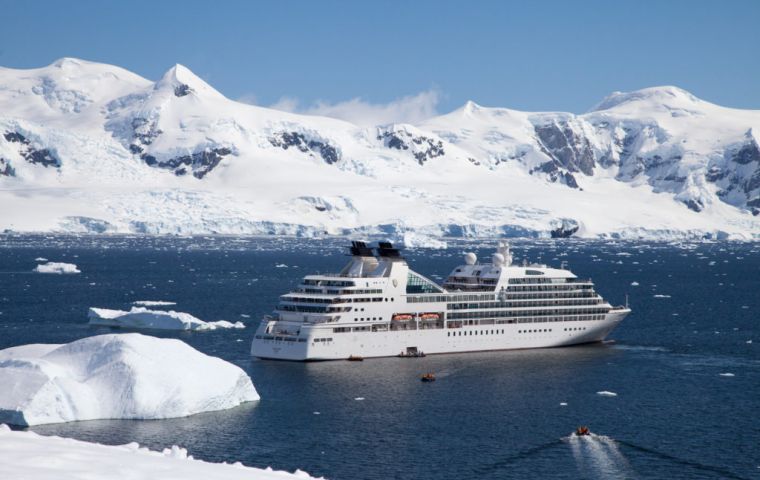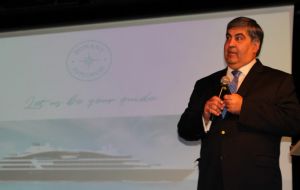MercoPress. South Atlantic News Agency
Expedition Cruising market booming: some 40 ships in the pipeline to replace worn out Soviet ice breakers
 Cruise lines from Celebrity Cruises to Crystal Cruises, Hapag Lloyd, Hurtigruten, Seabourn Line and Silversea Cruises, have plans for new expedition cruise ships
Cruise lines from Celebrity Cruises to Crystal Cruises, Hapag Lloyd, Hurtigruten, Seabourn Line and Silversea Cruises, have plans for new expedition cruise ships The expedition segment continues to be one of the most discussed elements of the cruise industry. Once a small niche, it is now poised for dramatic growth, prompting some to question how the market will develop.
The first new ships for expedition cruises began to appear late in 2018 with the growth expected to accelerate this year. 40 or more ships are already on order or rumored by 2023 for the market. Both new entrants and established cruise lines, ranging from Celebrity Cruises to Crystal Cruises, Hapag Lloyd, Hurtigruten, Seabourn Cruise Line and Silversea Cruises, have each announced plans for new expedition cruise ships.
“Expedition travel is moving beyond the age of worn out Soviet ice breakers,” said Rune Thomas Ege, Vice President, Global Communications for Hurtigruten Americans. Speaking on a panel discussion on expedition cruising at Seatrade Cruise Global in Miami, each of the participants agreed that the segment is primed for growth tapping into travelers’ desire for experiential travel.
“The consumer is changing,” explained Navin Sawhney, CEO, Americas, for PONANT. “They are looking to travel for a higher purpose today. They are focusing on the natural environment and native cultures, but they still want their creature comforts.”
Therein lies the impetus for the dramatic growth in expedition cruising. The segment, however, is also rapidly evolving and fragmenting even before the ships have entered service. “Hardware is now part of the changing experience,” explains Captain Ben Lyons, Chief Executive Officer, Expedition Voyage Consultants. He points out, “the experience will be different with 100 versus 500 people.”
Due to limitations imposed by some of the destinations, most of the lines are focusing on smaller ships, but there will be differences in the experience they offer. PONANT, for example, highlights that it is focused on small ships because “it is easy to get 150-200 like-minded people for the experience.” Sawhney joked, “It is not about eating sushi in the Antarctic – the destination is the center stage and the ship is the vehicle to get there.”
A number of different approaches are emerging with some of the more traditional players in the market declaring you “don’t need toys” referring to the spate of helicopters and submarines that some lines have said will be aboard their expedition ships. Ege of Hurtigruten feels that “toys are the wrong way to go, they will change the experience,” a sentiment shared by Sawhney, who says, “Toys will change the environment.” Captain Lyons agrees, pointing out that one element of the expedition trip is creating shared experiences for all the passengers as opposed to small segments of the audience.
Planning to sail to some of the most ecologically sensitive areas in the world, the expedition segment is acutely aware of the challenges. “Sustainability is more than a way of life (in this segment),” says Sawhney highlighting, for example, that PONANT has added an underwater lounge to “heighten awareness of the environment where we are sailing.”
While the panelists all felt that IAATO (International Association of Antarctica Tour Operators) has been successful in establishing guidelines for the Antarctic, they nonetheless worry about the cruise industry and the potential consequences. Ege points out that Hurtigruten has been sailing since 1893 and as a company, “we are seeing the impact of global warming on the seas, plastics in the ocean and glacier retreat.” He stated, “The cruise industry is dodging these issues. They are starting in the wrong place saying look at how much we have done …,” and instead Ege points to his company’s efforts such as eliminating the use of heavy oil and building dual-power or hybrid ships. PONANT has also gone fleet-wide to low sulfur fuel and eliminated plastics on its ships.
The growth in expedition cruising will present many challenges. One unseen element that Lyons highlights is the lack of experienced personnel. Most of the cruise lines are competing amongst a small pool of experienced freelancers who understand both organizing and managing the passenger experiences.
“Some lines are running training academies,” says Lyons, “but it is a sellers’ market for the qualified people.”
Countering the concerns regarding the potential for over tourism in these especially sensitive destinations, the panelists all agreed that the segment must carefully manage its operations and elements such as passenger landings. Lyons pointed out that in organizing expeditions his company has first reached out to the local populations to ensure that they were sensitive in planning their itineraries.
Expedition cruising, however, is also creating a new level of excitement in the industry and most importantly, “demand is coming for ‘new to cruise’,” points out Sawhney. While the large, well-known contemporary cruise lines are competing amongst themselves for passengers, the unique nature of the expedition experience is attracting travelers who might never have considered a cruise.
The panelists suggested this might be good for the cruise industry introducing new consumers to cruising and people who once they enjoyed an expedition cruise might be attracted to other more traditional destinations. “Perhaps, expedition becomes the next generation of small ship passengers too,” suggested Lyons.
The rapid growth in the expedition segment, along with the new set of challenges, however, may also lead to further consolidation in the business. While collectively the ships planned for expedition cruising have a total capacity similar to just one mega cruise ship, the challenge will still be to grow demand and establish operations quickly enough to balance the rapid growth in berths versus consumer interest.
Because of unique design features, the expedition ships would be harder to deploy to more traditional cruises, but experts agree that by expanding to more destinations, such as the lesser traveled parts of Asia or even the Caribbean, will help to support this growth.
It will be interesting to follow the development of the expedition market and see how it evolves into a new segment of global cruising.





Top Comments
Disclaimer & comment rulesCommenting for this story is now closed.
If you have a Facebook account, become a fan and comment on our Facebook Page!